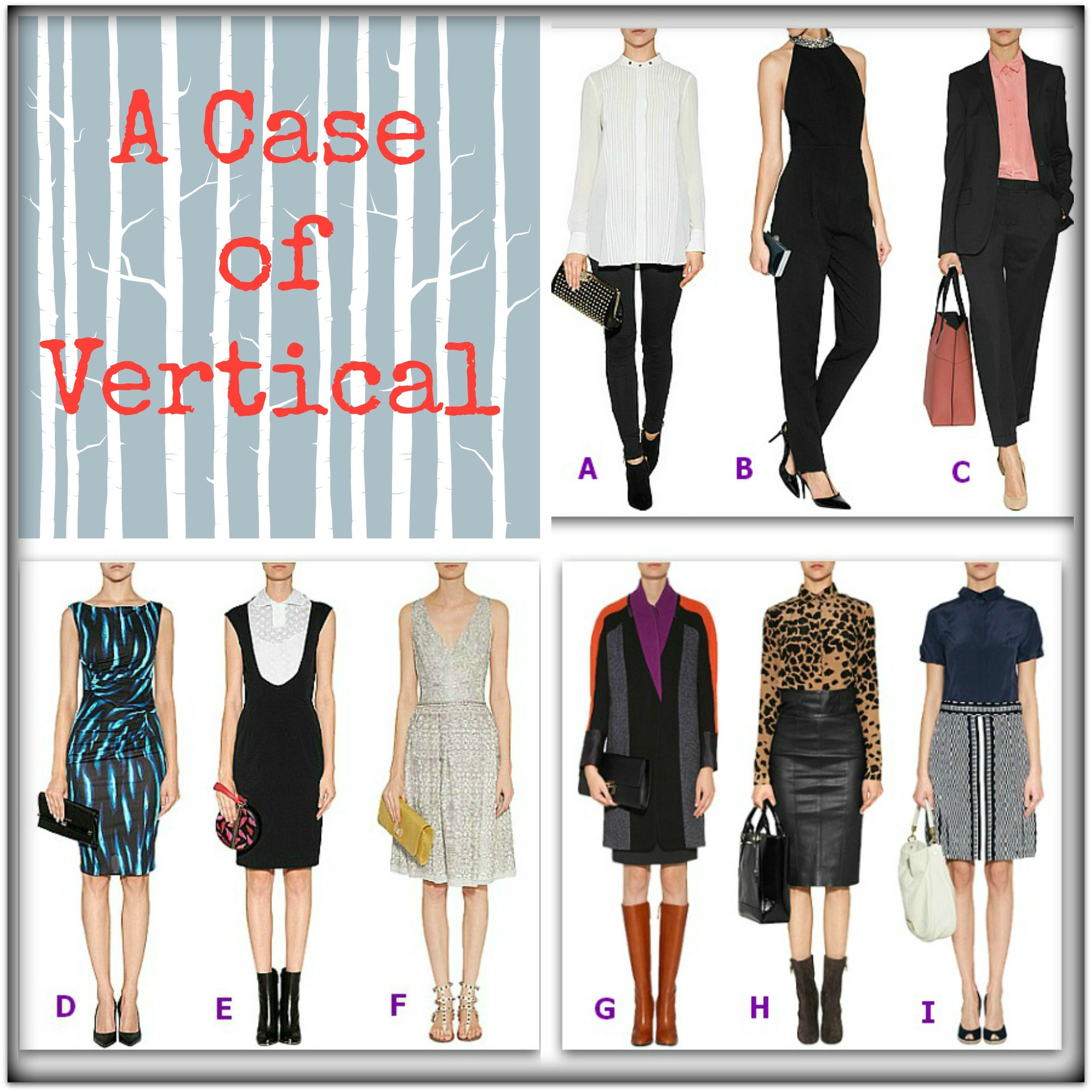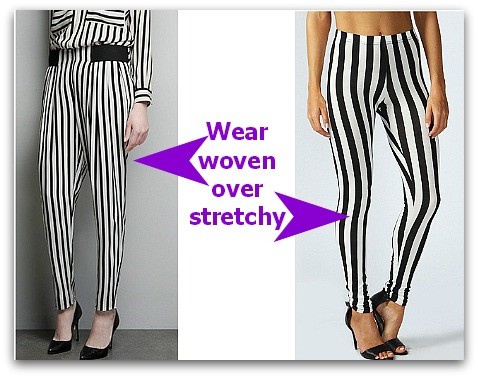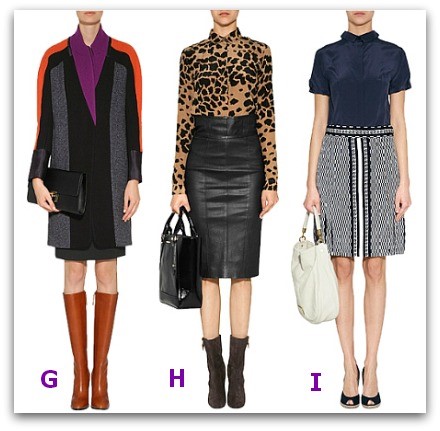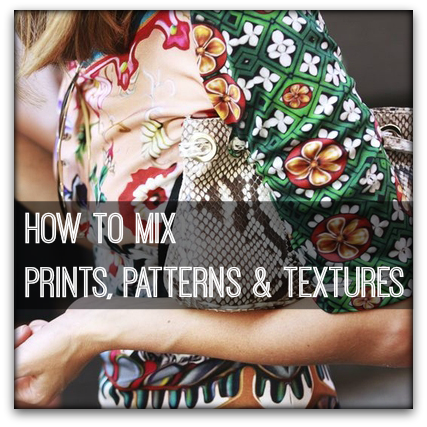
Imagine walking into a room or onstage and your audience sees you as strong professional woman, maybe one who’s even taller and more slender than you really are. How is this done? Through vertical design.
What is vertical design? It is clothing design elements which draws the eye up and down. The more vertical elements you use, the greater the elongating, slimming effect. For each element used, you can appear almost 4.5 pounds (2kg) thinner! This is the key for how to dress slimmer.
Vertical design is achieved through garments via:
- shape: straight and pencil skirts, straight and tapered pants, straight and tapered jackets/tops
- silhouette: semi- to very fitted (boxy and soft somewhat)
- structure: darts, panels, pleats, vertical folds, iron creases, seams
- embellishments: vertical lace paneling, pin tucks, ruffles
- fabric: vertical patterns and prints; fluid fabrics which follow curves.
- closures: zippers, buttons, lace-up
- accessories: oblong scarves, pendants, drop and hoop earrings, open vamp shoes, high heels and/or pointy toe shoes, nude shoes, hosiery that blends into hemline and shoes
- focal points: statement necklaces, medium to large or colorful earrings, applique design, embellished neckline/collar, scarf
- length: the longer the garment, the more vertical power
- grooming: long, short, straight hair; hair which stands up on top
Pictured are several outfits using vertical elements. Can you guess what they are (answers are at the end of the feature)?
Pants vs Skirts
Pants elongate the legs from waist to hem, which is usually at the ankle (J). Skirts vary more, going from waist to around the knee, leaving the legs exposed (K). The shorter the pants or the wider the skirt, the less elongating and slimming effect. Why? Because where the legs are exposed is usually an area of colour contrast that horizontally divides the length of the body (L). If hosiery and/or shoes/boots are worn in a similar contrast level (depth and colour) to the hemline colour, the vertical influence is maintained.

Run a Line
The most effective vertical line is one that runs down the center of your torso or limb (a seam, contrast stitching, zipper, row of buttons). However, the line’s position and width can negatively impact the elongating effect. This is definitely worth considering in light of how to dress slimmer.
Dress O’s wide vertical central panel, which is lighter than the sides, adds width to the torso. The wide central vertical seam in dress P divides the torso in two equal halves; however, the purple side is shinier, which makes it appear slightly wide than its darker matte counterpart. With sweater Q, the wider panel makes the torso appear wide regardless of the seam (vertical line). Sweater R is slimming due to the vertical seam being on the center of the torso.
A crease down the center of a pants is slimming. Pairing such with pointy toe high heel shoes looks even better.

Color in the Lines
Color coordinating your outfits can achieve an elongated look, either with an inner or outer line.
For example, a solid color single breasted jacket left open and paired with pants of the same or similar color creates an uninterrupted appearance from shoulder to pants hemline. Worn with a bright/light top and you create an outer vertical line (S). The darker colour is slimming because it recedes; a lighter/brighter colour advances, drawing the eye to the centre.
For variety, wear pants and a top of the same colour along with a solid colour single breasted jacket or cardigan in a different colour. This creates an inner vertical line (T). A light/bright jacket or cardigan should be avoided by those who are large above the waist because it will cause the upper body to appear wider.
Even the best-laid lines of style and trends can be undone if you add a focal point which minimizes the vertical effect. For example, wear a low-placed focal point (colourful shoes, border on skirt) and you draw the eye downward, which in turn ruins the illusion of slimness and height. However, all you have to do is wear something eye-catching up high as a counterbalance (an accessory, statement jewelry, make-up or hairstyle) to move the eye upward. Ta-da!
Beware the Stretchy Stripe
While it’s well-known that vertical stripes elongate your appearance, some fabrics undo all the good of those stripes. Stretchy, clingy fabrics with vertical stripes can stretch out of shape where you are widest and end up accentuating what you want to camouflage. Stick with non-stretchy fabrics and a semi-fitted silhouette for stripe success.

Toe the Line
Wow! Who knew design lines exerted so much influence over how people perceive your physical appearance? Did you know it also affects them psychologically? It’s true. Tall is associated with strong (think trees, skyscrapers, and pro basketball players). Someone with “upright” morals is viewed as having strong beliefs. So it’s natural to view someone who walks tall or has an elongated appearance to be some kind of authority.
You can use vertical design to as part of your plan for how to dress slimmer. If you want to appear more professional, more authoritative (and slimmer and taller), be sure to incorporate vertical elements. After all, pinstripes for menswear hasn’t lost its pro touch!
Answers
A: 1. pintucks in shirt, 2. skinny pants, 3. high focal point with button on collar
B: 1. one colour outfit, 2. raglan neckline drawing attention upwards, 3. embellished collar, 4. pointy toe shoes.
C: 1. outer vertical colour flow, 2 .strong focal point blouse
D: 1. semi fitted tubular dress, 2. vertical pattern, 3. pointy toe shoes
E: 1. solid coloured dark dress 2. eyes up focal point – white shirt, 3. pointy toe shoes.
F: 1. solid coloured dress
G: 1. knee high boots, 2. striped coat, 3. focal point on shoulders and at neck, 4. high heels, 5. pointy toe shoes.
H: 1. gored skirt, 2. high waistband on skirt, 3. high focal point – leopard blouse
I: 1. vertical pattern in skirt, 2. pointed toe shoes















Recent Comments